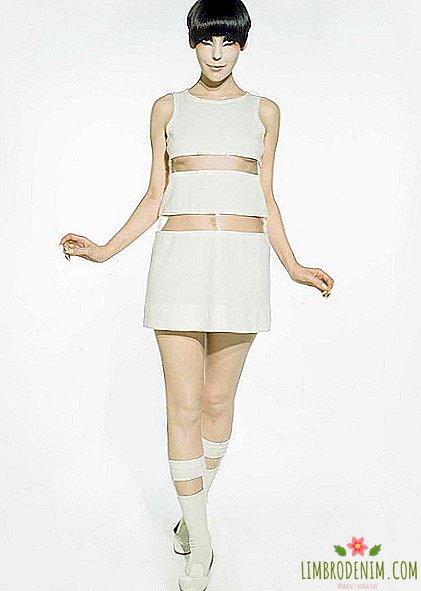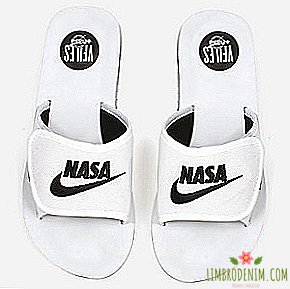Flare and mini: Why do we need fashion half a century ago
The last few years fashion has been reproached for losing touch with reality: critic Katie Horin in her manifesto called for choosing comfort instead of conceptuality, and readers of fashion publications were perplexed over each shooting, how and why IT is to be worn, and reasonably wondered how modern trends relate to the life of an "ordinary person." Fashion, interested in sales, and therefore, in the rapid attraction of attention, public relations and vivid magazine shootings, really rocking the boat too much. Designers rush from extremes to extremes: from androgyny to underlined sexuality, from infantilism and flirting with vulgarity to passion for sports lifestyle and street-culture. All these trends are only a slice of the last two years, but in reality are a reflection of the social and cultural phenomena of the last half century.


We come to a schizophrenic fashion that responds to the spirit of the times.

Epoch by epoch, designers rethought the experience and heritage of fashion of the past, which has been accumulating more and more. As a result, we have come to a complete schizophrenia and a mix of ideas that correspond to the schizophrenic spirit of the time. We have a choice of styles and trends for every taste, rapidly replacing each other, in which an ordinary buyer is easily confused. The concept of "fast fashion" requires us to consume more and more often - but the question of the golden mean, including universal and practical clothing, remains open in 2015.
In fact, we all need simple, but not boring, sexy, but not vulgar, feminine, but not banal, versatile, but not overly androgynous clothing that is easy to combine, can be worn from morning to evening, and to work, and to a party . Sounds like utopia. However, it was just such clothes that were once thought out - and it was in a landmark decade from the mid-60s to the mid-70s. It is noteworthy that in search of a way out of the crisis of ideas, fashion designers turned to her.

Until the 60s, high fashion, which it depicted the same Vogue, was the lot of wealthy and elite circles. Mothers, grandmothers, and daughters often looked the same, depending on which social stratum their family belonged to. Things created by designers did not imply practicality and versatility, instead they were most often complex and constraining movements. However, this in no way contradicted the lifestyle of the clients of fashion houses. But they were replaced by the youth of the 60s - a generation with an active lifestyle that was inspired by the beatniks and insurgents of the 50s, who wanted to be different from their parents by everything, including their appearance, and at the same time wear comfortable clothes. There was a request for a practical and trendy wardrobe.
The pioneer in this field was one of the main designers of the era, Yves Saint Laurent. His debut for Dior in 1958 already included trapezoid dresses, and the 1960 collection was called "Hipster" and consisted of leather jackets and skirts, short jackets and turtlenecks. With its simplicity, it shocked customers in the same way as Eddie Slimane’s debut for Saint Laurent with leather jackets and leather skirts half a century later. However, respectable customers for the changes were not yet ready and took them into hostility. After the Saint-Laurent subcultural collection, they were even suspended from business until Pierre Berger intervened - and a few years later the designer returned to his post.



60s and 70s - a breakthrough time in the field of practical and fashionable design

The period from the mid-60s to the mid-70s was innovative in all respects. First of all, there was a breakthrough in the field of design: beauty and precision of geometric cut appeared, but simplicity in production. New materials were used: PVC, vinyl, rubber, Lurex, metal, and even rodoid. We owe all of this to a whole group of mid-60s futuristic designers: Andre Kurreux, Paco Rabanne and Rudi Heinrich, led by Pierre Cardin. Paco Rabanne is revolutionizing the use of industrial materials, and André Cours tailoring dresses impressed by Le Corbusier’s architecture. They came up with a versatile set of minimalistic things: A-silhouette dresses, overalls, short skirts, ski sweaters, and sleeveless dresses. The designers were sure: this is exactly what the woman of the future should look like in her electric car and, judging by the modern collections, they turned out to be right. The idea of "less is better" at the same time catching up around the world. The legendary miniskirt was proposed by André Kurrej in 1964 in Paris, followed by Mary Quant in London and Betsy Johnson in New York.
At this time, the formation of a ready-made clothing market and a retail revolution were taking place. All new items were extremely functional and simple, and therefore in demand. There were stores that filled the youth: Biba and Bazaar in London, Paraphernalia in New York. Shopping is becoming a new kind of leisure, and fashion is part of everyday life. Mary Cuant, who opened the Bazzar store in London, was looking for a way to fill the shelves on a massive scale, and that was how she began to make clothes that were easy to play, practical, and easily combined with each other. Things were simply tailored to be repeated not only on an industrial scale, but also at home. As a result, more than thirty thousand Mary Quant mini-skirts were sold in London in 1967, but one can only guess how many of their copies were sewn by fashionistas themselves. Times have changed, and in 1968 Balenciaga closes its fashion house with the words: "Street fashion has ruined the high."
It is important that the designers of the late 60s sold not just things, but ready-made images. Mary Cuant to miniskirts initiated the production of colored tights, and also launched a line of decorative cosmetics Mary Quant Cosmetics. Her line included multicolored eye shadows, lipsticks, the waterproof mascara "Crybaby" (they said about her "Make up to make love in)" and a means for removing it "Peel", which went on sale in 1966. Later, its development and technology got Max Factor. Hairdresser Vidal Sassoon specifically for trapezoid dresses Quant came up with geometric short haircuts.

A little later, in the early 70s, American designers Roy Halston Frouick and Calvin Klein will support the idea of an easy-to-match wardrobe for women, based on shirts, pants, skirts, and discreet sheath dresses in their version. In 1972, Diana von Furstenberg solves the problem of quickly changing her daywear to evening wear with her dress with a smell. Comfortable knitwear is becoming an integral part of the market, and Itoni’s leaders are the Italians Missoni and the new designer Sonia Rykiel. The most practical thing enters women's mass fashion - trousers. And at once all kinds of styles: wide, shortened, pipes, flares. Today, pantsuit is in the wardrobe of each, but the first women's tuxedo Yves Saint Laurent in 1966 caused a shock.
New fashion answered not only the principles of practicality. Trapezoid dresses of the 60s shifted the emphasis from the waist to the hips, allowed to move freely and take unconstrained poses, which turned out to be consonant with the sexual revolution and a new wave of emancipation. However, versatility for the 60s does not mean neutral colors, as most often represent the basic wardrobe now. On the contrary, at the same time, a fever of color swept the world: with the advent of color television, color reigns everywhere, including fashion. Green, yellow, red dresses, orange tights, fuchsia and blue in outerwear - designers of the 60s are not shy about choosing colors and prints. Emanuel Ungaro and Kenzo Takada are the first to combine strips of different rhythms, cells, peas, and the youth skillfully follows them. The spirit of freedom and protest permeates the podium as the African-American civil rights movement picks up power. Designers are inspired by African motifs, while dark-skinned models attend the shows of Paco Rabanne, Pierre Cardin, Thierry Mugler, Hubert de Givenchy. Among them is Iman, the first African American to enter into a contract with Vogue. The lush, natural afro hairstyles are becoming a symbol of self-acceptance, pride and the strength of African culture, and it's nice that this is also remembered now.
The fashion of that time turned out to be open and receptive to social changes, so starting from the second half of the 70s everything will start breaking into it in increasing order: disco, punk, new age, androgyny, glam rock, kitsch, trash, avant-garde, new glamor But it was the decade from 1964 to 1975 that laid the foundations for a basic wardrobe and a viable but trendy design. She separated the elite fashion of the past from the clutter of styles and conceptuality of the future. In fact, this is the golden mean, which modern fashion lacks.


Nicolas Ghesquière rethought the wardrobe of the clients of the house of Louis Vuitton

It is not surprising that modern designers took up the work with this particular era. The ideas of half a century ago help solve the crisis of modern fashion, as once decided the crisis of fashion of the past. So, in 2014, Nicolas Ghesquière first appeals to the ideas of the 60s futurists, laconic and geometric silhouettes, things that are both feminine and not arguing with the dominant minimalism of the 2010s. Thus, Gesquière rethinks the wardrobe of the clients of the respectable Louis Vuitton house: neat, practical, concise and feminine. For three seasons in a row, at Louis Vuitton, you can see boots, turtlenecks, A-line dresses and miniskirts, A-line coat, cropped flares, baby doll short dresses, ankle boots, and slim suits. It seems that customers of such stability are only happy.
Following Geskyer, a dozen brands are turning to the retrofuturism of the late 60s with their mini and trapezium dresses, as well as the 70th with their flares, leather coats and platform shoes and clogs. Just look at the other recent collections to see this. Miu Miu has a crochet vest, psychedelic prints, flares, MSGM and Versace have flares, ski sweaters, short skirts and platform shoes, Thomas Tait and Calvin Klein have flares and trapezoid dresses, Carven has mini, pants trousers, turtlenecks, Acne - flared and “aviators”, Christian Dior - colorful tights and A-line dresses, things made of plastic and with a striped pattern. It is important that among these collections there are no hippie-chic with its variegated tunics and chintz dresses on the floor, which are commonly associated with the 70s and which offer only commercial brands like Emilio Pucci or Roberto Cavalli.
What do we do with all this cultural heritage now? It should be borne in mind that fashionable hits of the late 60s and early 70s are the easiest to adapt to modern life through combination with sports and everyday things. For example, flares are too typical of the past, and it’s better to pick a simple white jersey or t-shirt than an authentic blouse with a bow, choose sneakers or birkenshtoks, and not sandals on the platform. On the other hand, some variants of the combination of the late 60s seem to be immortal: a turtleneck plus a miniskirt, an A-silhouette coat in bright colors and pointed ballet flats, a trapezoid dress and boots with a small heel. This proves that sometimes it is better not to reinvent the wheel, but just look back.
Photo: courtesy of MOCA, André Courrèges





